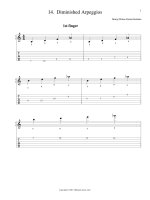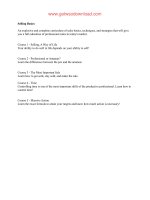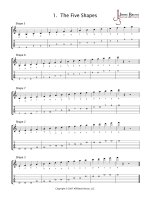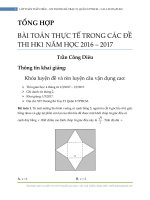05 1 integrity message authentication codes tủ tài liệu bách khoa
Bạn đang xem bản rút gọn của tài liệu. Xem và tải ngay bản đầy đủ của tài liệu tại đây (236.25 KB, 10 trang )
Online
Cryptography
Course
Dan
Boneh
Message
integrity
Message
Auth.
Codes
Dan
Boneh
Message
Integrity
Goal:
integrity,
no
confiden>ality.
Examples:
– Protec>ng
public
binaries
on
disk.
– Protec>ng
banner
ads
on
web
pages.
Dan
Boneh
Message
integrity:
MACs
k
message
m
tag
Alice
Generate
tag:
tag
←
S(k,
m)
k
Bob
Verify
tag:
?
V(k,
m,
tag)
=
`yes’
Def:
MAC
I
=
(S,V)
defined
over
(K,M,T)
is
a
pair
of
algs:
– S(k,m)
outputs
t
in
T
– V(k,m,t)
outputs
`yes’
or
`no’
Dan
Boneh
Integrity
requires
a
secret
key
message
m
Alice
Generate
tag:
tag
←
CRC(m)
tag
Bob
Verify
tag:
?
V(m,
tag)
=
`yes’
• ARacker
can
easily
modify
message
m
and
re-‐compute
CRC.
• CRC
designed
to
detect
random,
not
malicious
errors.
Dan
Boneh
Secure
MACs
ARacker’s
power:
chosen
message
a?ack
•
for
m1,m2,…,mq
aRacker
is
given
ti
←
S(k,mi)
ARacker’s
goal:
existenAal
forgery
•
produce
some
new
valid
message/tag
pair
(m,t).
(m,t)
∉
{
(m1,t1)
,
…
,
(mq,tq)
}
⇒
aRacker
cannot
produce
a
valid
tag
for
a
new
message
⇒
given
(m,t)
aRacker
cannot
even
produce
(m,t’)
for
t’
≠
t
Dan
Boneh
Secure
MACs
• For
a
MAC
I=(S,V)
and
adv.
A
define
a
MAC
game
as:
Chal.
k←K
b
m1
∈
M
t1
←
S(k,m1)
m2
,
…,
mq
t2
,
…,
tq
Adv.
(m,t)
b=1
if
V(k,m,t)
=
`yes’
and
(m,t)
∉
{
(m1,t1)
,
…
,
(mq,tq)
}
b=0
otherwise
Def:
I=(S,V)
is
a
secure
MAC
if
for
all
“efficient”
A:
AdvMAC[A,I]
=
Pr[Chal.
outputs
1]
is
“negligible.”
Dan
Boneh
Let
I
=
(S,V)
be
a
MAC.
Suppose
an
aRacker
is
able
to
find
m0
≠
m1
such
that
S(k,
m0)
=
S(k,
m1)
for
½
of
the
keys
k
in
K
Can
this
MAC
be
secure?
Yes,
the
aRacker
cannot
generate
a
valid
tag
for
m0
or
m1
No,
this
MAC
can
be
broken
using
a
chosen
msg
aRack
It
depends
on
the
details
of
the
MAC
Let
I
=
(S,V)
be
a
MAC.
Suppose
S(k,m)
is
always
5
bits
long
Can
this
MAC
be
secure?
No,
an
aRacker
can
simply
guess
the
tag
for
messages
It
depends
on
the
details
of
the
MAC
Yes,
the
aRacker
cannot
generate
a
valid
tag
for
any
message
Example:
protec>ng
system
files
Suppose
at
install
>me
the
system
computes:
filename
filename
F1
F2
t1
=
S(k,F1)
t2
=
S(k,F2)
filename
⋯
Fn
k
derived
from
user’s
password
tn
=
S(k,Fn)
Later
a
virus
infects
system
and
modifies
system
files
User
reboots
into
clean
OS
and
supplies
his
password
– Then:
secure
MAC
⇒
all
modified
files
will
be
detected
Dan
Boneh
End
of
Segment
Dan
Boneh









